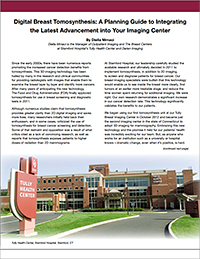
Editor's Note: This is the fourth installment of a five-part series adapted from the author's paper "Digital Breast Tomosynthesis: A Planning Guide to Implementing the Latest Advancement into Your Imaging Center." Links to parts 1, 2, & 3, in addition to the full paper, can be found at the bottom of this post.
Background:
We began using digital breast tomosynthesis in October 2012 - just the the second imaging center at the time to adopt 3D imaging for mammography in the entire state of Connecticut. As anyone who works for an institution like a university or hospital knows - dramatic change, even when it's positive, is hard. We faced a variety of of challenges integrating this technology into our facility and our workflow and feel the lessons we learned can benefit others as they consider implementing digital breast tomosynthesis into their hospital or practice.
The Straw that Broke the Camel's Back
Three months after implementation, the results were impressive!
We were back to screening 60 patients per day, our radiologists were comfortable with the new technology, and our technologists were following a successfully revised workflow. many of the outcomes we had hoped for at the beginning of this journey had become a reality.
The number of diagnostics and call-backs for reimaging plummeted. Our team was was identifying more cancers in earlier stages. It was exactly what we, as a hospital, had dreamed of, but in some ways, the struggles in our journey were just entering a new phase.
Because the radiologists now had greater faith in the technology, many of them began insisting that everything, from screenings to diagnostics, be handled with 3D imaging. In addition, thanks patients hearing more and more about the benefits of tomosynthesis in the news coupled with our own outreach and promotional programs, demand was exploding!
At the 3 month mark, we were handling 60 breast tomosynthesis screenings per day and were ecstatic. Patient #61, however, was the straw that broke the camel's back.
With such vigorous demand, the capacity of our one tomosynthesis room was exceeded. After our initial success we were determined not to let this progress in improving patient satisfaction (and our technologists' peace of mind) head in the opposite direction.
Clearly it was time to introduce another tomosynthesis room at Tully as well as make the case to add a tomosynthesis room at our other busy outpatient imaging center at Darien.
Next Installment: Seeing the Payoff
Read Parts 1, 2, & 3:
How We Implemented Digital Breast Tomosynthesis into Our Busy Imaging Center and Lived to Tell About It - Part 1 - The Journey Begins, then Falters
How We Implemented Digital Breast Tomosynthesis into Our Busy Imaging Center and Lived to Tell About It - Part 2 - A Champion (and Dramatic Workflow Changes) Emerge
How We Implemented Digital Breast Tomosynthesis into Our Busy Imaging Center and Lived to Tell About It - Part 3 - Stress Levels Go Through the Roof
Click on the thumbnail below to read the full paper:

Diella Mrnaci

